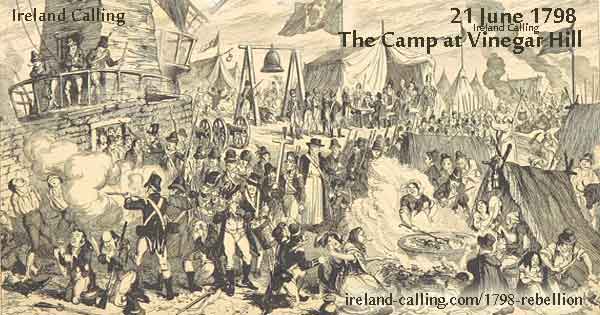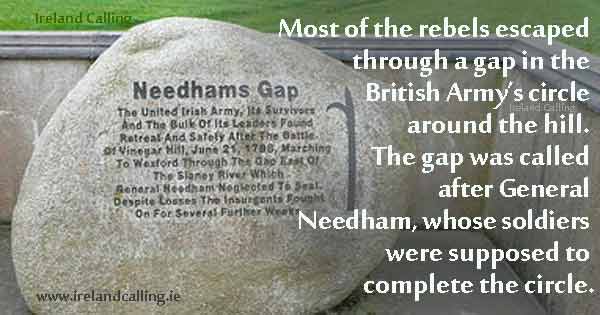The Battle of Vinegar Hill above the town of Enniscorthy in Co Wexford was one of the decisive encounters of the United Irishmen Rebellion of 1798.
The rebels were trying to consolidate their gains in Co Wexford but they were poorly equipped and so were quickly overcome by superior might of the British Army.
The 1798 Rebellion was organised by the United Irishmen led by Protestants Theobald Wolfe Tone and Henry Joy McCracken.
The aim was to unite Catholics, Prostestants and Presbyterians to provide a united front to overthrow British rule in Ireland.
The uprising was supposed to take place simultaneously across Ireland but due to poor communications and infiltration by British spies, it was reduced to isolated battles and skirmishes across the country.
Most of the substantial fighting took place in Co Wexford, where Father John Murphy had reluctantly taken up arms to help protect his parishioners from the brutality of the British Army.

The Wexford rebels had managed some victories against the British in relatively minor battles such as Oulart Hill, but there had also been some heavy defeats, most notably at New Ross and Arklow where they lost 2,000 and 1,000 men respectively.
They had been engaging in battles in small units and coming out defeated.

The rebel leaders included Father Murphy and Bagenal Harvey, Cornelius Grogan, Mathew Keogh, and Anthony Perry, who were Protestants.
They decided that all Wexford United Irishmen should gather at Vinegar Hill on 21 June for one ultimate battle against the British.
An estimated 20,000 answered the call but although they were large in number, they were poorly armed and included women and children seeking safety from the brutality of rampaging soldiers.
The British Army, led by General Gerard Lake, had an instruction to not only defeat the rebels but to crush their spirit as had been done to those in the north at battles at Antrim and Ballynahinch.
There were an estimated 10,000 British troops, fewer in number than the rebels but much better equipped.
They surrounded the hill with the plan to attack from all sides leaving no way of escape for the rebels.
Lake wanted to seal off all escape routes by dividing his troops into four columns with their own commanding generals.
They fired cannons and gunshots at the rebels, who were lambs to the slaughter with most armed only with pikes. The battle lasted about two hours and hundreds of United Irishmen were killed.
Most of them managed to escape through a small gap in the British Army’s circle around the hill.
The gap was called “Needham’s Gap” after General Needham, whose soldiers were supposed to complete the circle but were late arriving.

Execution of Father Murphy
Fighting also took place in the town of Enniscorthy at the foot of the hill on the banks of the River Slaney. The rebels put up a stong resistance but were driven out by artillery fire.
Following the battle the British soldiers went on a rampage, raping the women who had sought protection, killing fleeing rebels and burning buildings.
The rebel leaders Harvey, Grogan, Keogh and Perry were all executed. Father Murphy was captured a month or so later. He was stripped, flogged and hanged.
His head was cut off and placed on a spike, and his corpse burnt in a barrel of tar opposite a Catholic church. The British soldiers forced the Catholics in the area to open their windows so they could smell the burning corpse.
The escaped rebels mostly fled into the Wicklow mountains, and although some continued to fight in small groups, the British had taken back Wexford, the last remaining rebel stronghold.
There were occasional outbreaks afterwards but the 1798 Rebellion was effectively over.
